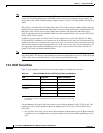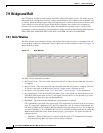
7-15
Cisco ONS 15310-MA SDH Reference Manual, Release 9.1 and Release 9.2
78-19417-01
Chapter 7 Circuits and Tunnels
Virtual Concatenated Circuits
• For SW-LCAS circuits used when interoperating with ONS 15454 ML-Series cards, you cannot add
or delete members.
• For non-LCAS VCAT circuits that use CE-100T-8 or CE-MR-6 cards, adding and deleting members
to/from the circuit is possible, but service-affecting. For ML-100T-8 cards, you cannot add or delete
members from non-LCAS VCAT circuits without affecting the entire VCAT circuit.
Table 7-7 summarizes the VCAT capabilities for the CE-100T-8 and ML-100T-8 cards.
7.7.5 Open-Ended VCAT
For applications where the complete end-to-end VCAT circuit is not in a CTC managed network, CTC
will only see either the source or the destination of the Virtual Concatenated Group (VCG) and some of
the intermediate nodes. Figure 7-5 shows an end-to-end VCAT circuit. The termination points of the
end-to-end VCAT circuit, with VCAT functionality, are referred to as the VCAT-Source and
VCAT-Destination. The termination points of the CTC managed circuit, which is the Open-Ended VCAT
circuit, is referred to as simply the Source and Destination.
Table 7-7 ONS 15310-MA SDH VCAT Card Capabilities
Card Mode
Add a
Member
Delete a
Member
Support
locked-enabled,o
utOfGroup
CE-100T-8 LCAS Yes Yes Yes
SW-LCASNoNoNo
Non-LCAS Yes
1
1. For CE-100T-8 cards, you can add or delete members after creating a VCAT circuit with no protection. During
the time it takes to add or delete members (from seconds to minutes), the entire VCAT circuit will be unable
to carry traffic.
Yes
1
No
ML-100T-8 LCAS Yes Yes Yes
SW-LCASNoNoNo
Non-LCAS No No No
CE-MR-6 LCAS Yes Yes Yes
SW-LCAS Yes Yes No
Non-LCAS Yes Yes No


















